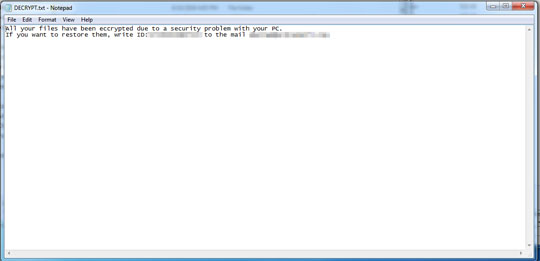RANSOM_KASITOO.R038C0DCP18
TR/RedCap.hmjvh (Avira (no cloud)); Ransom:Win32/Kasitoo.A!rsm (Microsoft);
Windows


Threat Type: Ransomware
Destructiveness: No
Encrypted: No
In the wild: Yes
OVERVIEW
Downloaded from the Internet, Dropped by other malware
This Ransomware arrives on a system as a file dropped by other malware or as a file downloaded unknowingly by users when visiting malicious sites.
TECHNICAL DETAILS
946,702 bytes
EXE
No
25 Mar 2018
Terminates processes, Displays message/message boxes, Encrypts files
Arrival Details
This Ransomware arrives on a system as a file dropped by other malware or as a file downloaded unknowingly by users when visiting malicious sites.
Process Termination
This Ransomware terminates the following processes if found running in the affected system's memory:
- sql
- chrome.exe
- ie.exe
- firefox.exe
- opera.exe
- safari.exe
- taskmgr.exe
- 1c
- mysqld.exe
- sqlservr.exe
- sqlmangr.exe
- sqlbrowser.exe
- fdhost.exe
- fdlauncher.exe
- MsDtsSrv.exe
- Ssms.exe
- sqlwriter.exe
- sqlagent.exe
- SQLBackupMaster.Service.exe
Other Details
This Ransomware does the following:
- Executes the following commands to terminate processes if found in the memory:
- taskkill /F /IM sql /T
- taskkill /F /IM chrome.exe /T
- taskkill /F /IM ie.exe /T
- taskkill /F /IM firefox.exe /T
- taskkill /F /IM opera.exe /T
- taskkill /F /IM safari.exe /T
- taskkill /F /IM taskmgr.exe /T
- taskkill /F /IM 1c /T
- taskkill /F /IM mysqld.exe /T
- taskkill /F /IM sqlservr.exe /T
- taskkill /F /IM sqlmangr.exe /T
- taskkill /F /IM sqlbrowser.exe /T
- taskkill /F /IM fdhost.exe /T
- taskkill /F /IM fdlauncher.exe /T
- taskkill /F /IM MsDtsSrv.exe /T
- taskkill /F /IM Ssms.exe /T
- taskkill /F /IM sqlwriter.exe /T
- taskkill /F /IM sqlagent.exe /T
- taskkill /F /IM SQLBackupMaster.Service.exe /T
- Executes the following commands to edit the boot configuration data file:
- bcdedit.exe bcdedit /set {default} bootstatuspolicy ignoreallfailures -> Disables Windows Error Recovery
- bcdedit.exe bcdedit /set {default} recoveryenabled no -> Disables Startup Repair
- Executes the following command to delete $recycle.bin:
- del /Q /F /S {Malware Directory}$recycle.bin
- Executes the following commands to delete shadow copies:
- vssadmin.exe delete shadows /all /quiet
- wmic shadowcopy delete
- Executes the following command to encrypt files:
- gpg.exe --recipient crypt -o ""{Malware directory}{file to be encrypted}.30778.crypt"" --encrypt ""{File to be encrypted}""
Ransomware Routine
This Ransomware avoids encrypting files with the following strings in their file name:
- .crypt
- DECRYPT.txt
It avoids encrypting files with the following strings in their file path:
- temp
- TEMP
- windows
- WINDOWS
- Windows
- Recycle
- windows
- Windows
- WINDOWS
- Program Files
- PROGRAM FILES
- ProgramData
- gnupg
It appends the following extension to the file name of the encrypted files:
- .crypt
It leaves text files that serve as ransom notes containing the following text:
- {Encrypted Directory}DECRYPT.txt

SOLUTION
9.850
14.149.21
25 Mar 2018
14.150.00
26 Mar 2018
Step 1
Before doing any scans, Windows XP, Windows Vista, and Windows 7 users must disable System Restore to allow full scanning of their computers.
Step 2
Identify and terminate files detected as RANSOM_KASITOO.R038C0DCP18
- Windows Task Manager may not display all running processes. In this case, please use a third-party process viewer, preferably Process Explorer, to terminate the malware/grayware/spyware file. You may download the said tool here.
- If the detected file is displayed in either Windows Task Manager or Process Explorer but you cannot delete it, restart your computer in safe mode. To do this, refer to this link for the complete steps.
- If the detected file is not displayed in either Windows Task Manager or Process Explorer, continue doing the next steps.
Step 3
Search and delete these files
- {Encrypted Directory}\DECRYPT.txt
Step 4
Scan your computer with your Trend Micro product to delete files detected as RANSOM_KASITOO.R038C0DCP18. If the detected files have already been cleaned, deleted, or quarantined by your Trend Micro product, no further step is required. You may opt to simply delete the quarantined files. Please check the following Trend Micro Support pages for more information:
Step 5
Restore encrypted files from backup.
NOTES:
Enabling Volume Shadow Service
- Run the command prompt (cmd.exe) as administrator.
- Enable Volume Shadow Service by typing the following command: net start vss
Enabling Windows Error Recovery
- Enable Windows Error Recovery Screen on Startup use the following command: bcdedit /set {default} bootstatuspolicy displayallfailures
Enabling Startup Repair
- Run the command prompt (cmd.exe) as administrator.
- Enable Startup Repair use the following command: /bcedit /set {default} recoveryenabled Yes
Did this description help? Tell us how we did.

